Complete Solutions to Subjective of chapter ELECTRICAL MEASURING INSTRUMENTS of Class 12 book with complete answers and questions
| Class 12 | PHYSICS |
| Chapter | ELECTRICAL MEASURING INSTRUMENTS |
| CENGAGE PHYSICS | Subjective |
| Number Of Questions | 18 |
| Academic Year | 2023-24 |
The potentiometer wire `AB` is `600` cm long.
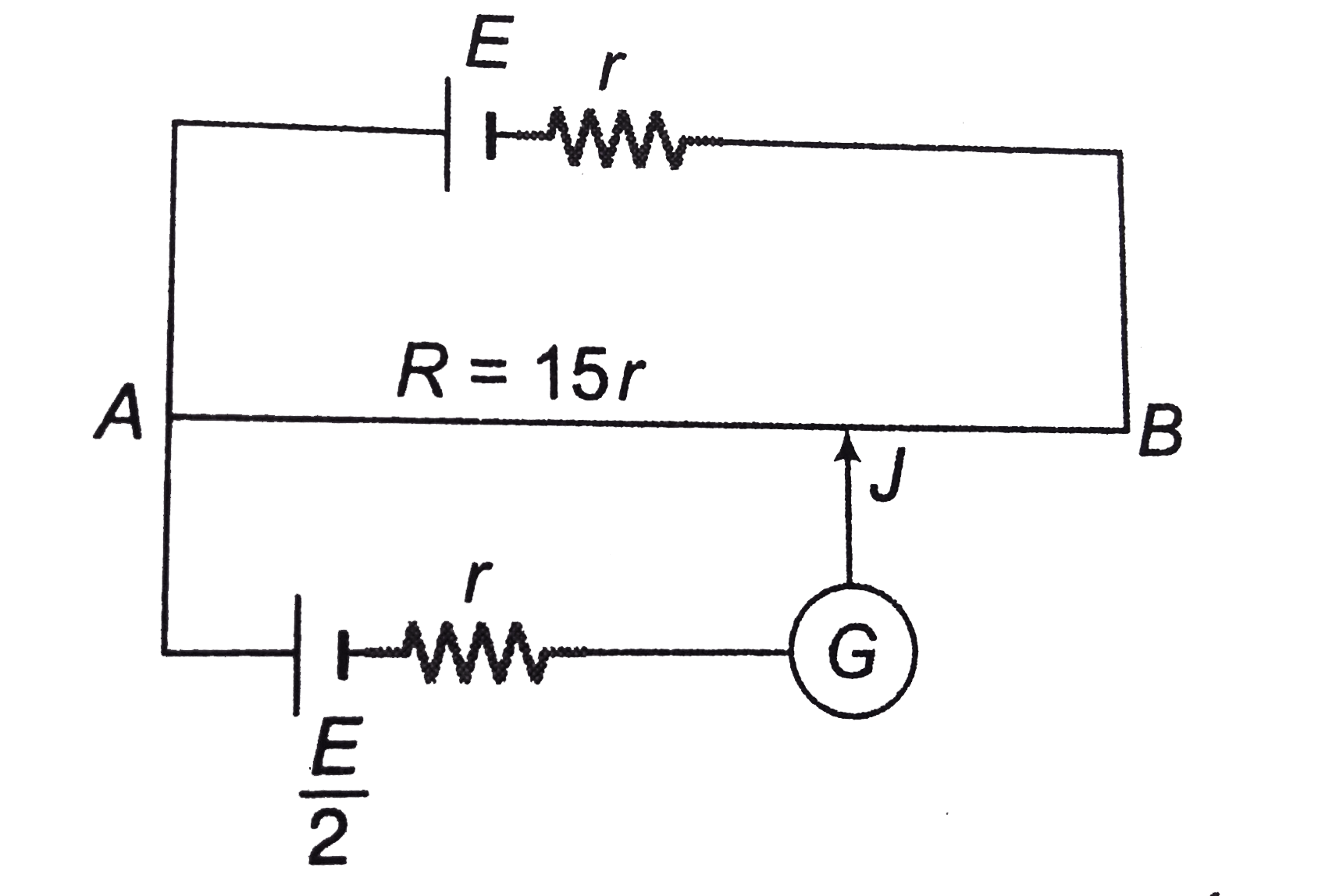 a. At what distance from A should be jockey `J` touch the wire to get zero deflection i the galvanometer.
a. At what distance from A should be jockey `J` touch the wire to get zero deflection i the galvanometer.
b. If the jockey touches the wire at a distance `560 cm` from A, what will be the current through the galvanometer.03:36View SolutionFigure 6.32 shows a meter bridge in the (which is nothing but a particle wheastone bridge), consisting of two resistors `X` and `Y` together in parellel with a meter long constantan wire of uniform cross section.


with the help of a movable contact `d`, one can change the ratio of resistance of the two segments of the wire until a sensitive galvanometer `G` connected across `b` and `D` shows no deflection. The null point is found to be at a distance of `33.7 cm`. The resistor `Y` is shunted by a resistance of `12 Omega`, and the null point is found to shift by a distance of `18.2 cm`. Determine the resistance of `X` and `Y`.08:11View SolutionThe circuit shows in Fig . `6.33` shows the use of potentiometer to measure the internal resistance of a cell.
(a) When the key is open, how does the balance point change, if the driver cell decreases ?
(b) When the key is closed, how does the balance point change, if `R` is increased, keeping the current from the driver cell constant ?
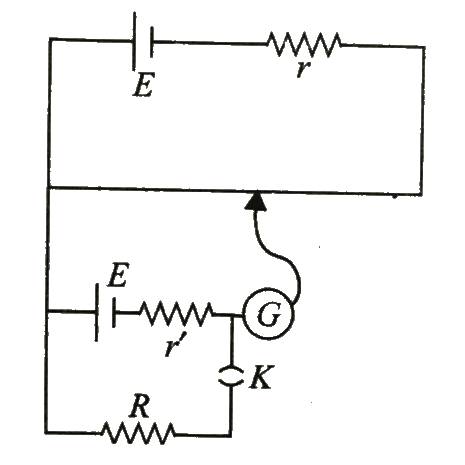 05:29View Solution
05:29View SolutionLet `V` and `I` respresent, respectively, the readings of the voltmeter and ammetre shows in Fig. `6.34`, and let `R_(V)` and `R_(V)` be their equivalent resistances. Because of the resistances of the meters, the resistnce `R` is not simply equal to `V//I`.
(a) When the circuit is connected as shows in Fig. `6.34` (a), shows that `R = (V)/(I) - R_(A)`
Explain why the true resistance `R` is always less than `V//I`.
(b) When the connections are as shows in Fig.`6.34` (b)
Show that `R = (V)/(I - (V//R_(V)))`

Explain why the true resistance `R` is always greater than `V//I`.
(c ) Show that the power delivered to the resistor in part
(i) is `IV - I^(2) R_(A)` and that in part (ii) is `IV - (V^(2)//R_(V))`08:45View SolutionYou are given two resistors `X` and `Y` whose resistances are to be determined using an ammeter of resistance `0.5 Omega` and a voltmeter of reistance `20 k Omega`. It is known that `x` is in the range of a few ohms. While `Y` is in the range of several thousand ohms. In each case, while of the following two connections (Fig. `6.35`) would you choose for resistance measurement? Justify your answer quantiatively. [Hint : For each connection, determine the error in resistnce measurement. The connection that corresponds to a smaller error (for a given range of resistance) is to be perferred.]
 06:42View Solution
06:42View SolutionFigure 6.36 shows a potentiometer with a cell of emf `2.0 V` and internal resistance `0.4 Omega` maintaining a potential drop across the resistor wire `AB`. A standard cell that maintains a constant emf of `1.02 V` (for very moderate current up to emf `mu A`) gives a balance point at `67.3 cm` length of the wire. To ensure very low current is drawn the standard cell, a very high resistance of `600 k Omega` is put in series with it, which is shorted close to the balance point. The standard cell is then replaced by a cell of unknown emf `epsilon` and the balance point found, similary, turns out to be at `82.3 cm` length of the wire.
a. What is the value of `epsilon`?
b.What purpose does the high resistance of `600 k Omega` have?
c. Is the balance point affected by this high resistance?
d. Is the balance point affected by internal resistance of the driver cell?
e. Would the method work in the above situation if the driver cell of the potentiometer had an emf of `1.0 V` instead of `2.0 V`?
f. Would the circuit work well for determining an extermely small emf, say of the order of a few `mV` (such as the typical emf of a thermocouple)? If not, how will you modify the circuit ?
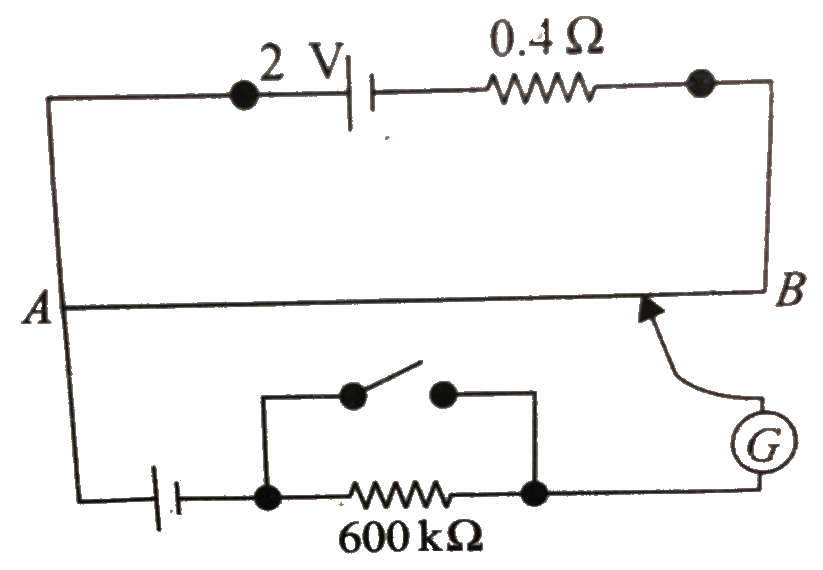 View Solution
View SolutionIn a meter bridge circuit, the two resistances in the gap are `5 Omega` and `10 Omega`. The wire resistance is `4 Omega`. The emf of the cell connected at the ends of the wire is `5 V` and its internal resistance is `1 Omega`. What current will flow through the galvenometer of resistance `30 Omega` if the contact is made at the midpoint of wire ?
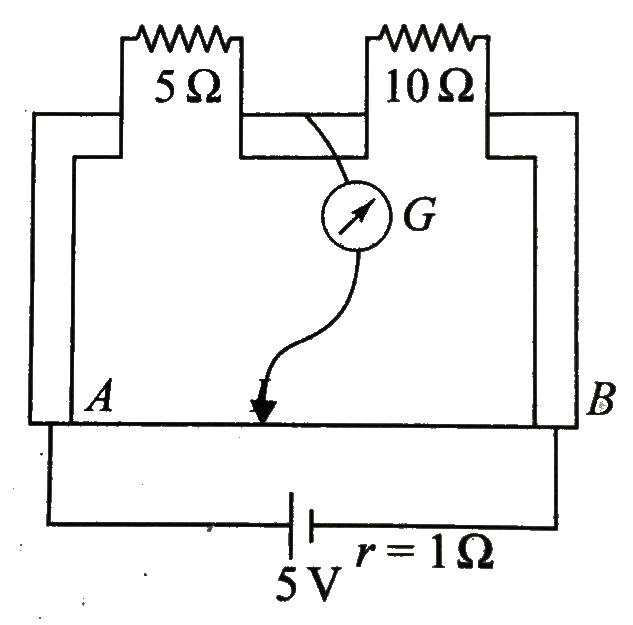 07:44View Solution
07:44View SolutionIn the gives circuit, a meter bridge is shows in a balanced state. The bridge wire has a resistance of `1 Omega cm^(-1)`. Find the value of the unknown resistance `X` and the current draws from the battery of negligible internal resistance.
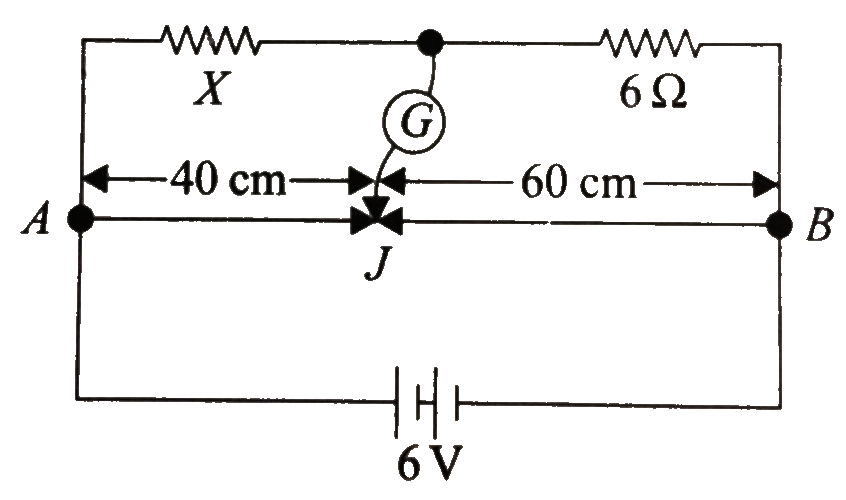 02:28View Solution
02:28View SolutionIn an experiment with a post office box, the radio of arms are `1000 : 10`. If the value of the third resistance is `999 Omega`, find the unknows resistance.
03:04View SolutionA galvanometer reads `5*0V` at full scale deflection and is graded according to its resistance per volt at full scale deflection as `5000OmegaV^-1`. (i) How will you convert it into a voltmeter that reads `20V` at full scale deflection? (ii) Will it still be graded `5000OmegaV^-1`? (iii) Will you prefer this voltmeter to one that is graded `2000OmegaV^-1`?
04:34View SolutionA battery of emf `1.4 V` and internal resistance `2 Omega` is connected to a resistor of `100 omega` resistance through an ammeter. This resistance of the ammeter is `4//3 Omega`. A voltmeter has also been connected to find the potential difference across the resistor.
a. Draw the circuit diagram.
b. The ammeter reads `0.02 A`. What is the resistance of the voltmeter?
c. The voltmeter reads `1.1 V`. What is the error in the reading?09:16View SolutionA potentiometer wire has a length of `10 m` and resistance `4 Omega m^(-1)`. An accumulator of emf `2 V` and a resistance box are connected in series with it. Culculate the resistance to be introduced in the box so as to get a potential gradient of
(a) `0.1 V//m` and (b) `0.1 mVm^(-1)`.05:22View SolutionIn an experiment with a potentiometer, `V_B=10 V`. R is adjusted to be `50 Omega` (see figure) . A student wanting to measure voltage `E_1` of a battery ( approx. 8V) finds no null point on the last (4th) segment of the potentiometer.Find the resistance of the potentiometer wire and potential drop per unit length across the wire in the second case.
 View Solution
View SolutionWhat is the advantages of using thick metallic strips to join wires in a potentiometer ?
02:24View Solution`AB` is a potentiometer wire Fig. If the value of `R` is increased, in which direction will the balance point `J` shift ?
05:00View SolutionWhile doing an experiment with potentiometer (see figure) it was found that the deflection is one sided and (i) the deflection decreased while moving from one and A of the wire, to the end R, (ii) the deflection increased, while the jockey was moved towards the end D.
(a)Which terminal positive and negative of the cell `E_1` is connected at X in case (i) and how is `E_1` related to E ?
(b)Which terminal of the cell `E_1` is connected at X in case (i in a) ?
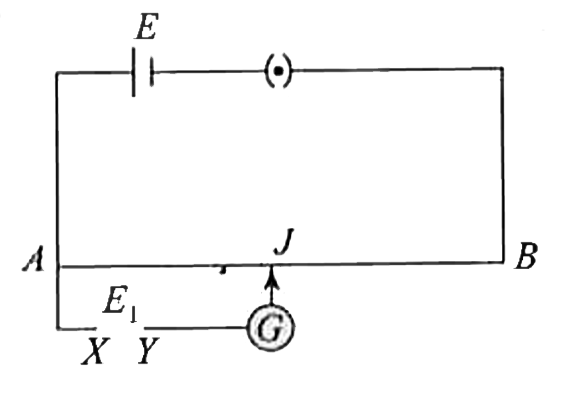 View Solution
View SolutionA battery of e.m.f. 10 V and internal resistance `2 Omega` is connected in primary circuit with a uniform potentiometer wire and a rheostat whose resistance is fixed at `998 Omega`.A battery of unknown e.m.f. is being balanced on this potentiometer wire and balancing length is found to be 50 cm.When area of cross section of potentiometer wire is doubled, then balancing length is found to be 75 cm.
(i)Calculate e.m.f. of the battery.
(ii)Calculate resistivity of potentiometer wire if length of wire is 100 cm and area of cross-section (initially) is `100 cm^2`.View SolutionWhat are the advantages of the nll-point method in a Wheatstone bridge ? What additional measurements would be required to calculate `R_("unknown")` by any other method ?
03:24View Solution
Subjective questions and complete solutions for chapter ELECTRICAL MEASURING INSTRUMENTS of CENGAGE PHYSICS (HINGLISH) of Class 12
